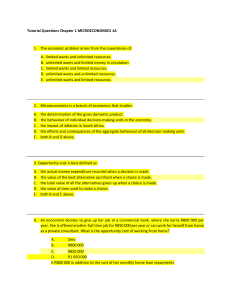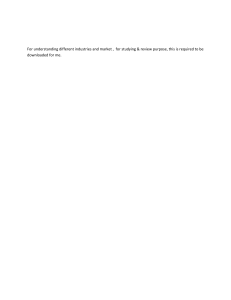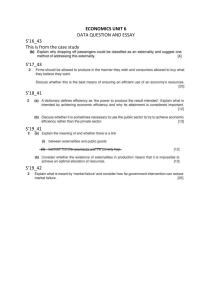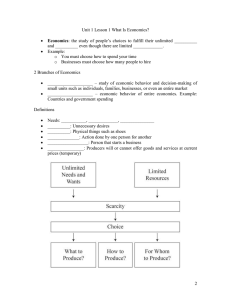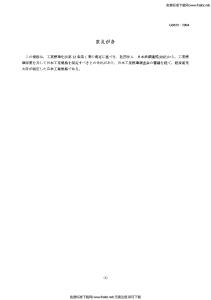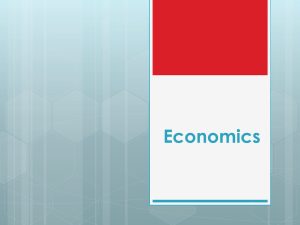chapter-1-tutorial-questions-and-chapter-2-tutorial-questions
advertisement
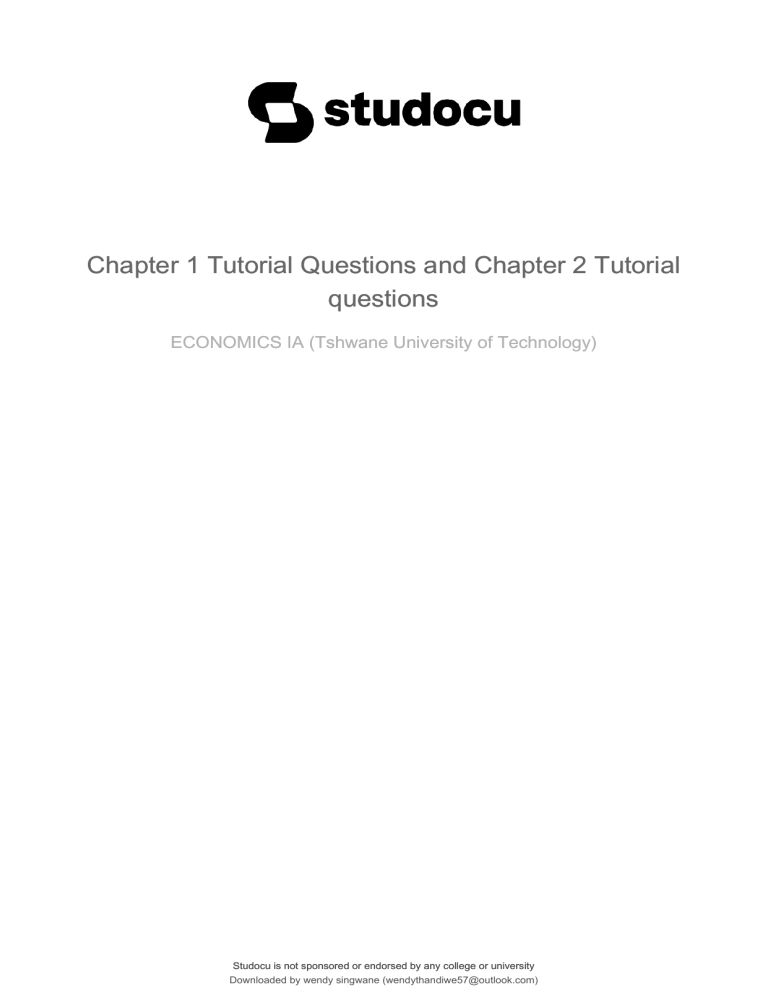
lOMoARcPSD|18513518 Chapter 1 Tutorial Questions and Chapter 2 Tutorial questions ECONOMICS IA (Tshwane University of Technology) Studocu is not sponsored or endorsed by any college or university Downloaded by wendy singwane (wendythandiwe57@outlook.com) lOMoARcPSD|18513518 Tutorial Questions Chapter 1 MICROECONOMICS 1A 1. The economic problem arises from the coexistence of: A. B. C. D. E. limited wants and unlimited resources. unlimited wants and limited money in circulation. limited wants and limited resources. unlimited wants and unlimited resources. unlimited wants and limited resources. 2. Microeconomics is a branch of economics that studies: A. B. C. D. E. the determination of the gross domestic product. the behaviour of individual decision-making units in the economy. the impact of inflation in South Africa. the effects and consequences of the aggregate behaviour of all decision-making units. both B and D above. 3. Opportunity cost is best defined as: A. B. C. D. E. the actual money expenditure incurred when a decision is made. the value of the best alternative sacrificed when a choice is made. the total value of all the alternatives given up when a choice is made. the value of time used to make a choice. both B and C above. 4. An economist decides to give up her job at a commercial bank, where she earns R800 000 per year. She is offered another full-time job for R850 000 per year or can work for herself from home as a private consultant. What is the opportunity cost of working from home? A. Zero B. R800 000 C. R850 000 D. R1 650 000 E.R800 000 in addition to the cost of her monthly home loan repayments Downloaded by wendy singwane (wendythandiwe57@outlook.com) lOMoARcPSD|18513518 5. A production possibility frontier shows: A. B. C. D. E. the maximum combination of inputs that can be used to produce output in a typical economy. the maximum revenue that can be generated from the sale of output produced by limited resources in an economy. the minimum quantities of commodities that can be produced from limited but fullyemployed resources in an economy. the maximum quantities of commodities that can be produced from limited but fullyemployed resources in an economy. the quantities of factors of production available to produce goods and services in an economy. Downloaded by wendy singwane (wendythandiwe57@outlook.com) lOMoARcPSD|18513518 The diagram below shows an economy’s production possibilities for two goods: aeroplanes and motor vehicles. Use this diagram to answer the question below. 6. With reference to the above production possibilities frontier, we can say that: A. the opportunity cost of producing 0a motor vehicles is 0b aeroplanes. B. the production of both motor vehicles and aeroplanes appears to require similar resources in similar proportions. C. the opportunity cost of producing one more motor vehicle is higher at f than at g. D. the opportunity cost of producing one more aeroplane is higher at g than at f. E. the opportunity cost of producing 0a motor vehicles is cb aeroplanes. Use the diagram below, which shows production possibilities for beer and textbooks, to answer this question. Downloaded by wendy singwane (wendythandiwe57@outlook.com) lOMoARcPSD|18513518 7. The opportunity cost of producing an additional textbook would be greatest at: A. B. C. D. E. A. B. C. D. E. 8. Economists tend to disagree because: A. B. C. D. they tend to be difficult. they might be biased. they use different scales on their production possibility frontiers. one economist might calculate total production in rands and the other economist might calculate total production in dollars. 9. The problem of economising is essentially one of deciding how to make the best use of A. B. C. D. E. virtually unlimited resources to satisfy limited wants. virtually unlimited resources to satisfy virtually unlimited wants. limited resources to satisfy virtually unlimited wants. limited resources to satisfy limited wants. limited resources to generate wants. Downloaded by wendy singwane (wendythandiwe57@outlook.com) lOMoARcPSD|18513518 10. Read the following statements and then answer the question that follows. Economics concerns itself with i. a systematic understanding of patterns of production, consumption and distribution of goods and services ii. a study of money, banking, capital formation and wealth. iii. a study of how limited resources are used to satisfy unlimited human wants. iv. a study of the application of scarce means to a multitude of human wants. 11. Which of the above statements can be associated with the broad subject matter studied in economics? A. B. C. D. E. None of them. All of them. Only statements i, ii and iii. Only statements i, iii and iv. All except statement iii. 12. A basis for the systematic study of economics exists because A. B. C. D. E. resources are scarce in relation to material wants. governments interfere with the efficient allocation of scarce resources. individual economic actors cannot be relied upon to make rational economic decisions. resources are plentiful relative to wants, therefore an allocation problem arises. the market consistently fails to allocate resources efficiently, thereby establishing the need to study economics. 13. Microeconomics is a branch of economics that studies A. the determination of national income. B. the behaviour of individual decision-making units in the economy. C. the impact of unemployment in South Africa. D. the effects and consequences of the aggregate behaviour of all decision-making units. E. both B and D above. 14. Macroeconomics is a branch of economics that studies A. the determination of total economic activity. B. the behaviour of individual decision-making units in the economy. Downloaded by wendy singwane (wendythandiwe57@outlook.com) lOMoARcPSD|18513518 C. decisions by firms regarding the most efficient use of resources. D. the effects and consequences of the aggregate behaviour of all decision-making units. E. both A and D above. 15. The axes of the production possibility curve measure A. B. C. D. E. quantities of productive inputs. quantities of finished commodities. quantities of raw materials. values of finished commodities. values of raw materials. 16. A production possibility curve shows A. the maximum combination of inputs that can be used to produce output in a typical economy. B. the maximum revenue that can be generated from the sale of output produced by limited resources in an economy. C. the minimum quantities of commodities that can be produced from limited but fully-employed resources in an economy. D. the maximum quantities of commodities that can be produced from limited but fully-employed resources in an economy. E. the quantities of factors of production available to produce goods and services in an economy. 17. Use a sentence or two to explain the relationships between wants, means, scarcity and choice. Wants are plentiful, but the means to satisfy those wants are scarce. Because the means are scarce, choices have to be made. 18. Distinguish between microeconomics and macroeconomics and provide two examples of microeconomic issues and two examples of macroeconomic issues in South Africa today. Macroeconomics is concerned with the economy as a whole, while microeconomics focuses on a particular part of the economy. Among the most important macroeconomic issues in South Africa are economic growth and employment creation. Microeconomic issues include the way in which electricity tariffs are determined and the degree of competition in the retail clothing market. 19. Explain why economics is classified as a social science. Downloaded by wendy singwane (wendythandiwe57@outlook.com) lOMoARcPSD|18513518 Economics is a social science because it deals with people, their hopes, fears and ambitions and the ways in which they interact. Downloaded by wendy singwane (wendythandiwe57@outlook.com)

